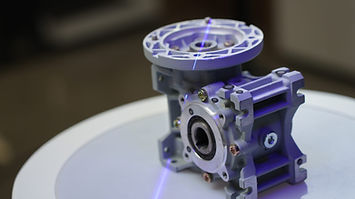
How We Do Things:
Our 3D Scanning Process
Curious about the 3D scanning process? Learn how we've honed our craft to get your parts 3D scanned and reverse engineered faster than ever before!


1
Small stickers, known as “targets,” are placed on/around your part. These keep the 3D scanner aligned in space as it moves around in space. (Don’t worry, we have several other methods of applying these targets that won’t damage your surface finish!)
2
Your parts are 3D scanned using a metrology-grade blue laser scanner, with resolution up to 50 micron. That’s only 0.05mm! These 3D scans are colorless, but if you have a part that needs to be scanned in color, contact us to check our capability.
3
The scan file is cleaned up and shared to you, generally within a few hours of scan completion. This file is in STL format, and is only a reference. It can be 3D printed if you want to replicate your part, or we can also provide a converted solid model for use in your assemblies to design mounts, clamps, add-ons, modifications, and more!
4
If you need to take it one step further and need a fully reverse engineered solid model with correct features for machining or design alterations, we can do that too! We’re experts in high-end reverse engineering and 3D modeling software to ensure your 3D model is accurate to real life. This file is generally sent in a STEP or parasolid format, but other formats are possible.

"What Can I Have 3D Scanned?"
Almost any object can be captured with 3D scanning, given the right preparation. Most parts— including shiny or reflective surfaces—can be scanned without modification. Transparent materials, however, require a temporary dulling spray to accurately capture their geometry.
We can scan parts as small as a ½-inch cube up to over 10 feet in length. One of our 3D scanning systems has virtually no size limit, though file size and detail depend on part complexity and scan resolution.
